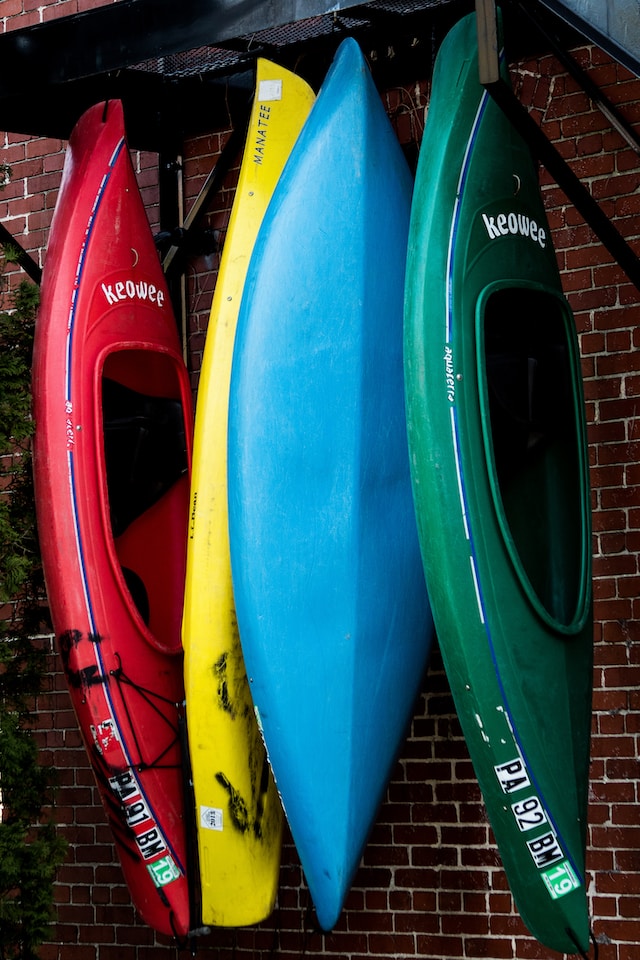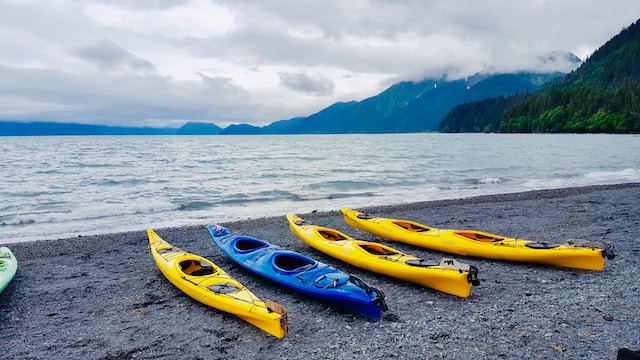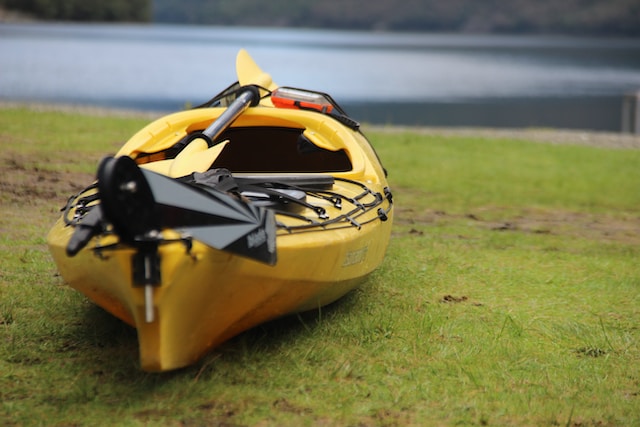Can You Paint A Kayak? Everything You Need to Know
Can you paint a kayak? In this comprehensive guide, we’ll answer all your questions about painting a kayak, including the materials you can paint, the reasons why you might want to paint a kayak, what paint to use, and step-by-step instructions for painting your kayak.
Whether you have a polyethylene, fiberglass, or wooden kayak, we’ve got you covered.
The Possibility Of Painting A Kayak
Many kayakers wonder if it’s possible to paint their kayaks.
The good news is that painting a kayak is indeed possible, regardless of the material it is made of.
Whether you have a plastic polyethylene kayak, a fiberglass kayak, or even a wooden kayak, painting can be a great way to customize and protect your vessel.
We will delve into the specifics of painting kayaks made from different materials and provide you with all the information you need to embark on your own kayak painting project.
Can You Paint A Kayak?
Before you start painting a kayak, it’s important to understand the particularities of the material your kayak is made of.
Different kayak materials require different approaches when it comes to painting.
In this section, we’ll dive into the details of each kayak material, including polyethylene, fiberglass, and wooden kayaks.
We’ll discuss the characteristics of each material and outline the best practices for painting a kayak made from each material.
Polyethylene Kayaks
Polyethylene kayaks are popular due to their durability and affordability.
However, painting a polyethylene kayak can be challenging because the material is not inherently paint-friendly.
To successfully paint a polyethylene kayak, it’s crucial to properly prepare the surface by sanding and using a suitable primer.
Additionally, choosing a paint specifically formulated for plastic materials will ensure optimal adhesion and longevity of the paint job.
Fiberglass Kayaks

Fiberglass kayaks have a smooth and non-porous surface, making them relatively easier to paint compared to other materials.
When painting a fiberglass kayak, it’s essential to thoroughly clean and sand the surface to ensure good paint adhesion.
Using a high-quality marine-grade paint designed for fiberglass surfaces will provide the best results.
Fiberglass kayaks also allow for more creative freedom when it comes to choosing different colors and finishes.
Wooden Kayaks
Wooden kayaks offer a traditional and aesthetically pleasing option for paddlers.
When painting a wooden kayak, it’s important to choose a paint that is compatible with wood and offers good protection against moisture and UV rays.
Applying a suitable primer before painting will help enhance adhesion and durability.
It’s also crucial to properly seal and maintain the wooden surface to prevent water damage and preserve the paint job.
Why Paint A Kayak?
There are several reasons why you might want to paint your kayak.
Painting a kayak offers a range of benefits, from protecting the kayak’s surface from UV damage and fading to personalizing the aesthetics of your vessel.
Whether you’re a recreational paddler looking to add some flair to your kayak or a serious angler in need of a camouflage paint job, painting a kayak is a popular choice among kayak enthusiasts.
One of the main reasons to paint a kayak is to protect it from UV damage and fading.
The sun’s UV rays can cause the original colors of your kayak to fade over time, potentially decreasing its visual appeal.
By applying a protective paint coat, you can shield your kayak from harmful UV rays and maintain its vibrant appearance for longer.
Additionally, painting a kayak allows you to customize its aesthetics according to your preferences.
You can choose from a wide variety of colors, designs, and patterns to create a unique and personalized look for your kayak.
Whether you want a sleek and minimalist design or a bold and eye-catching one, painting gives you the freedom to express your creativity and make your kayak stand out on the water.
Furthermore, painting a kayak can also serve practical purposes.
For anglers, a camouflage paint job can help blend the kayak into its surroundings, providing a tactical advantage while fishing.
It can make your kayak less visible to fish and allow you to get closer to your target without startling them.
This can greatly enhance your fishing experience and increase your chances of success.
In addition to the aesthetic and practical benefits, painting your kayak also provides an opportunity to give new life to an older or worn-out vessel.
By refreshing its appearance with a fresh coat of paint, you can make your kayak look brand new and keep it in top condition for years to come.
In conclusion, painting a kayak offers numerous reasons and benefits, including UV protection, customization, practical advantages for anglers, and rejuvenating older kayaks.
Whether you’re looking to protect, personalize, or enhance your kayak, painting is a popular choice among kayak enthusiasts for its ability to transform the look and performance of your vessel.
What Paint Should You Use On A Kayak?
Choosing the right paint for your kayak is crucial to ensuring a successful and long-lasting paint job.

There are different types of paint suitable for kayaks, each with its own advantages and considerations.
Let’s explore the options and find the best paint for your kayak.
Marine-Grade Paints
Marine-grade paints are specifically formulated for use in marine environments, making them ideal for kayaks.
These paints provide excellent durability and resistance to water, UV rays, and fading.
They are designed to withstand the harsh conditions that kayaks often face, such as exposure to saltwater and constant sunlight.
Marine-grade paints offer a wide range of color options, so you can find the perfect shade for your kayak.
When choosing a marine-grade paint, look for high-quality brands like Interlux, Pettit, or Epifanes.
Water-Based Paints
Water-based paints are another popular option for painting kayaks.
They are easy to use and clean up with water, making them a convenient choice for DIY enthusiasts.
Water-based paints are typically more environmentally friendly compared to oil-based paints.
They also have low VOC (volatile organic compounds) levels, which means they release fewer harmful fumes during application.
While water-based paints offer good adhesion and durability, they may not be as resistant to water and UV rays as marine-grade paints.
However, if you primarily paddle in calm waters and don’t expose your kayak to extreme conditions, water-based paints can be a suitable choice.
Related Content
- CAN YOU PAINT A KAYAK? EVERYTHING YOU NEED TO KNOW
- HOW TO SHIP A KAYAK? THE ULTIMATE GUIDE
- ESSENTIAL KAYAKING SAFETY TIPS FOR ALL
- HOW TO CLEAN A KAYAK? – THE ULTIMATE GUIDE
Oil-Based Paints
Oil-based paints are known for their durability and longevity.
They provide excellent protection against water, UV rays, and fading.
Oil-based paints create a hard and glossy finish, offering superior resistance to scratches and abrasions.
However, they can be more challenging to work with compared to water-based paints, as they require mineral spirits or turpentine for cleanup.
Oil-based paints also have a higher VOC content, so adequate ventilation is necessary during application.
If you’re looking for a paint that will withstand heavy use and adverse conditions, oil-based paints are a reliable option.
When choosing the paint for your kayak, consider factors such as the color options available, the durability required for your kayaking activities, and the compatibility with the material of your kayak.
For example, polyethylene kayaks may require specific types of paint that adhere well to the plastic surface.
It’s also essential to choose paint that dries quickly and cures properly to ensure a smooth and long-lasting finish.
Before starting your project, read product labels and consult with experts or professionals to ensure you select the best paint for your kayak.
Preparing Your Kayak For A New Paint Job
Stripping Down Accessories
Before you start painting your kayak, it’s important to strip down the accessories to ensure a smooth and even painting surface.
Begin by removing seats, hardware, and any other removable components from your kayak.

This will make it easier to paint the kayak’s main body without any obstacles.
Set aside the accessories in a safe place where they won’t get damaged or lost during the painting process.
Cleaning and Sanding Techniques
Once you’ve removed the accessories, it’s time to clean your kayak thoroughly.
Use a mild detergent and warm water to scrub the surface and remove any dirt, grime, or grease.
Pay special attention to areas that are prone to buildup, such as the cockpit and the hull.
Rinse the kayak well after cleaning to ensure that no residue is left behind.
After cleaning, it’s important to sand the kayak’s surface to create a better bond between the paint and the kayak material.
Start by using fine-grit sandpaper to gently sand the entire surface of the kayak.
This will help remove any imperfections and create a rough texture for the paint to adhere to.
Make sure to sand evenly and avoid applying too much pressure, as this can damage the kayak’s finish.
Acetone For A Final Wipe
Once the kayak is clean and sanded, it’s crucial to wipe it down with acetone for a final cleaning before painting.
Acetone is a powerful solvent that helps remove any residual contaminants and oils from the surface of the kayak.
Soak a clean, lint-free cloth with acetone and wipe the entire surface of the kayak, ensuring that you cover all areas.
This will help remove any remaining debris and provide the best possible surface for paint adhesion.
Remember to work in a well-ventilated area and wear protective gloves when handling acetone, as it is a strong chemical.
Allow the kayak to dry completely before proceeding with the painting process.
Brush And Spray Painting Techniques
When it comes to painting your kayak, you have two main options: brush painting or spray painting.
Each technique has its own advantages and considerations, so let’s compare them to help you decide which method is best for your kayak painting project.
Brush Painting
Brush painting involves using a paintbrush to apply the paint directly onto the kayak’s surface.
This method provides more control and precision, allowing you to easily navigate around curves and contours.
It is especially suitable for detailed designs and intricate patterns.
With brush painting, you can choose from a wide range of paintbrush sizes to achieve the desired stroke width.
It allows for layering and blending of colors, giving you more artistic freedom.
Additionally, brush painting is a relatively inexpensive option, as it requires minimal equipment.
However, brush painting may require multiple coats to achieve full coverage, which can be time-consuming.
It can also result in visible brush marks if not applied smoothly and evenly.
Furthermore, brush painting may not provide the same level of finish quality as spray painting.
Spray Painting
Spray painting involves using an airbrush or spray gun to apply the paint in a fine mist onto the kayak’s surface.
This method offers a quicker and more even application, covering large areas with minimal effort.
It is particularly suitable for solid color coats and uniform finishes.
With spray painting, you can achieve a smooth and professional-looking finish with no visible brush marks.
It allows for consistent coverage and faster drying times.
Additionally, spray painting can be more efficient when painting multiple kayaks or larger surfaces.
However, spray painting requires more equipment, including an airbrush or spray gun, compressor, and protective gear.
It also requires a well-ventilated area or a paint booth to minimize overspray and ensure safety.
Additionally, spray painting can be more challenging to control, especially when dealing with intricate designs or smaller areas.
In conclusion, the choice between brush painting and spray painting depends on your specific preferences and project requirements.
Brush painting offers more control and detail, while spray painting provides a faster and more even application.
Consider factors such as the complexity of your design, the desired finish quality, and your level of experience.
Ultimately, choose the technique that best suits your needs and allows you to create the kayak of your dreams.
UV Damage And Fading: How Painting Can Help
Exposure to the sun’s UV rays can cause damage and fading to your kayak’s original colors.
When you spend hours paddling on the water or exploring sunny coastal areas, protecting your kayak from UV damage becomes essential.
This is where painting your kayak can make a significant difference.
By painting your kayak with UV-resistant paint, you can provide an effective barrier against the harmful effects of UV rays.
Whether your kayak is made of polyethylene, fiberglass, or wood, specific paints can offer superior UV protection to prevent fading and keep your kayak looking vibrant for longer.
UV-resistant paints contain special additives that help to reflect or absorb UV radiation, reducing its impact on the kayak’s surface.
These paints act as a shield, protecting the underlying materials from deterioration.
By investing in UV protection for your kayak through painting, you can extend its lifespan and maintain its aesthetic appeal.
If you want to enjoy your kayak in its original colors for years to come, consider painting it with a UV-resistant paint designed specifically for kayaks.
Not only will this help prevent fading, but it will also provide an added layer of protection against other environmental factors such as saltwater, moisture, and abrasion.
Remember, a painted kayak doesn’t just look great; it also serves as a shield against UV damage.
So, when it comes to protecting your investment and preserving the beauty of your kayak, adding a layer of UV-resistant paint is the way to go.
Step-By-Step Guide To Painting Your Kayak
Now that you have all the necessary information, it’s time to embark on your kayak painting journey.

Follow these instructions to achieve a professional-looking paint job on your kayak, whether you’re a beginner or an experienced DIY enthusiast.
Step 1: Prepping the Area
Before you begin painting, ensure that you have a clean and well-ventilated workspace.
Choose an outdoor area or a well-ventilated garage with a temperature range of 50-85 degrees Fahrenheit.
Lay out a tarp or drop cloth to protect the ground and gather all the necessary tools and materials.
Step 2: Cleaning and Sanding the Kayak
Thoroughly clean the kayak’s surface using mild detergent and water.
Remove any dirt, grease, or debris using a soft cloth or sponge.
Once the kayak is clean, use a fine-grit sandpaper (around 220 grit) to lightly sand the surface. Sanding will create a rough texture and help the paint adhere better.
Step 3: Priming the Kayak (optional)
If you’re painting a polyethylene kayak, it’s recommended to apply a plastic-friendly primer before painting.
This will enhance paint adhesion and durability.
Follow the manufacturer’s instructions for the primer application, including drying times.
Step 4: Applying the Paint
Choose a marine-grade paint specifically formulated for kayaks.
Using a paintbrush or a spray gun, apply thin and even coats of paint to the kayak’s surface.
Start from the top and work your way down, ensuring full coverage. Allow each coat to dry completely before applying the next coat.
Step 5: Allowing the Paint to Cure
After you’ve applied the final coat of paint, allow the kayak to dry in a well-ventilated area for the recommended amount of time.
This will vary depending on the type of paint used, so refer to the manufacturer’s instructions for specific curing times.
Avoid touching or moving the kayak during this period to prevent any smudging or damage to the paint.
Step 6: Finishing Touches
Once the paint has fully cured, inspect the kayak for any imperfections or areas that require touch-ups.
Use a fine brush or sponge to fix any small blemishes.
If desired, apply a clear protective topcoat to add an extra layer of durability and shine to the paint job.
By following these step-by-step instructions, you can paint your kayak with confidence and achieve a professional finish.
Remember to take your time, follow safety precautions, and enjoy the process of transforming your kayak with a fresh new look.
Do You Need Marine Grade Paint for Your Kayak?
When it comes to painting your kayak, marine grade paint is often recommended for its durability and water resistance.
This specialized paint is specifically designed to withstand the harsh conditions of the marine environment, making it an ideal choice for kayaks exposed to water, sun, and other elements.

Advantages Of Marine Grade Paint
There are several advantages to using marine grade paint for your kayak.
Firstly, marine grade paint offers superior protection against UV damage, preventing fading and discoloration caused by prolonged exposure to the sun’s rays.
Additionally, this type of paint is formulated to resist saltwater corrosion, protecting your kayak’s surface from the corrosive effects of seawater.
Moreover, marine grade paint provides excellent adhesion and durability, ensuring that your paint job remains intact even with regular use and exposure to water.
Cost Considerations
While marine grade paint offers numerous benefits, it is generally more expensive than regular paint options.
The higher cost can be attributed to the specialized formulation and additional features that make marine grade paint suitable for marine applications.
However, it is important to consider the long-term value and protection that marine grade paint provides, especially if you frequently use your kayak in saltwater or under intense UV exposure.
Investing in marine grade paint can help extend the lifespan of your kayak and maintain its aesthetic appeal.
Alternatives To Marine Grade Paint
If the cost of marine grade paint is a concern, there are alternatives available that can still provide excellent results.
One option is to use high-quality enamel paint that offers good durability and weather resistance.
While not specifically designed for marine use, enamel paint can be a budget-friendly alternative that provides adequate protection for your kayak.
Another alternative is using epoxy paint, which offers excellent adhesion and durability.
However, it is important to note that epoxy paint requires additional preparation and application steps compared to traditional marine grade paint.
Ultimately, the choice between marine grade paint and alternatives depends on your individual needs, usage patterns, and budget.
If you frequently use your kayak in saltwater or under intense sun exposure, investing in marine grade paint may be worth the extra cost.
However, if you primarily paddle in freshwater and are looking for a more budget-friendly option, alternatives can still provide satisfactory results.
Consider your specific circumstances and consult with experts or professionals in the field to determine the best paint choice for your kayak painting project.
Oil-Based Vs Water-Based Paint: What’s Best For Kayaks?
When it comes to choosing paint for your kayak, you’ll come across two main options: oil-based paint and water-based paint.
Each type has its own unique characteristics and considerations.
Let’s take a closer look at the differences between oil-based and water-based paint to help you determine the best option for your kayak.

Durability:
Oil-based paint is known for its excellent durability and resistance to wear and tear.
It forms a hard and protective coating that can withstand harsh conditions and provide long-lasting protection.
On the other hand, water-based paint may not be as durable, especially in high-traffic areas prone to scratches and abrasions.
Flexibility:
One advantage of water-based paint is its flexibility.
It expands and contracts with the kayak’s material, allowing it to withstand movements and vibrations without cracking or peeling.
This can be particularly beneficial for kayaks that are frequently exposed to changing weather conditions and water movements.
In contrast, oil-based paint may not have the same level of flexibility.
Resistance to Wear and Tear:
While both oil-based and water-based paints offer some level of protection against wear and tear, oil-based paint typically has better resistance to chemicals, solvents, and UV rays.
If you frequently paddle in areas with strong sunlight or use your kayak for fishing, oil-based paint may provide superior protection against fading, discoloration, and damage caused by UV exposure.
Ease of Application:
When it comes to ease of application, water-based paint has the advantage. It is generally easier to work with and clean up, as it can be diluted with water and requires less time for drying.
Oil-based paint, on the other hand, may require the use of solvents for thinning and cleanup, and it typically has a longer drying time.
However, it’s important to note that oil-based paint may provide a smoother and more professional finish if applied correctly.
In conclusion, the choice between oil-based and water-based paint for your kayak depends on several factors, including your desired durability, flexibility, resistance to wear and tear, and ease of application.
Consider the specific qualities of each paint type and take into account your kayak’s intended use and environmental conditions.
By making an informed decision, you can select the most suitable paint for your kayak and ensure a beautiful and long-lasting paint job.
Maintaining Your Painted Kayak: Tips and Best Practices
Once you’ve successfully painted your kayak, it’s important to take the necessary steps to maintain and protect the new paint job.
By following these tips and best practices, you can ensure the longevity and beauty of your painted kayak.
Cleaning Techniques:
Clean your painted kayak regularly to remove dirt, salt, and other debris that can damage the paint.
Use a gentle, non-abrasive soap and warm water to wash the surface.
Avoid using harsh chemicals or abrasive materials that can scratch the paint.
Rinse thoroughly and dry your kayak with a soft cloth to prevent water spots and minimize the risk of paint damage.
Use of Protective Coatings:
Consider applying a protective coating to your painted kayak to add an extra layer of protection against UV rays, saltwater, and abrasions.
There are various types of kayak-specific coatings available, such as marine-grade wax or UV-resistant clear coats.
These coatings can help preserve the paint and enhance its durability.
Be sure to follow the manufacturer’s instructions when applying the protective coating.
General Care Guidelines:
Avoid dragging or scraping your kayak on rough surfaces, as this can cause scratches to the paint.
Lift and carry your kayak properly to prevent unnecessary damage.
Store your kayak in a safe and sheltered area when not in use to protect it from extreme weather conditions and direct sunlight.
Additionally, consider using a kayak cover or storing it in a protective bag to further safeguard the painted surface.
By following these maintenance practices, you can protect your painted kayak from chipping, fading, and other forms of paint damage.
With proper care, your beautifully painted kayak will continue to impress and provide enjoyment for years to come.

Conclusion
In conclusion, painting a kayak offers a great opportunity to customize the appearance of your vessel and protect it from the elements.
Whether you have a polyethylene, fiberglass, or wooden kayak, understanding the specific requirements of each material is crucial for achieving the best results.
By choosing the right type of paint, properly preparing your kayak, and following the step-by-step guide, you can achieve a professional-looking paint job.
Regardless of your skill level, painting your kayak can be a rewarding DIY project that enhances both the aesthetics and longevity of your vessel.
Whether you’re looking to add a personal touch, protect against UV damage, or even achieve a camouflage design, painting your kayak allows you to unleash your creativity and make your kayak truly unique.
So what are you waiting for? Take the plunge and give your kayak a fresh new look.
With the comprehensive information provided in this guide, you have everything you need to confidently embark on your own kayak painting adventure.
Enjoy the process, and may your newly painted kayak bring you joy and admiration every time you hit the water!






